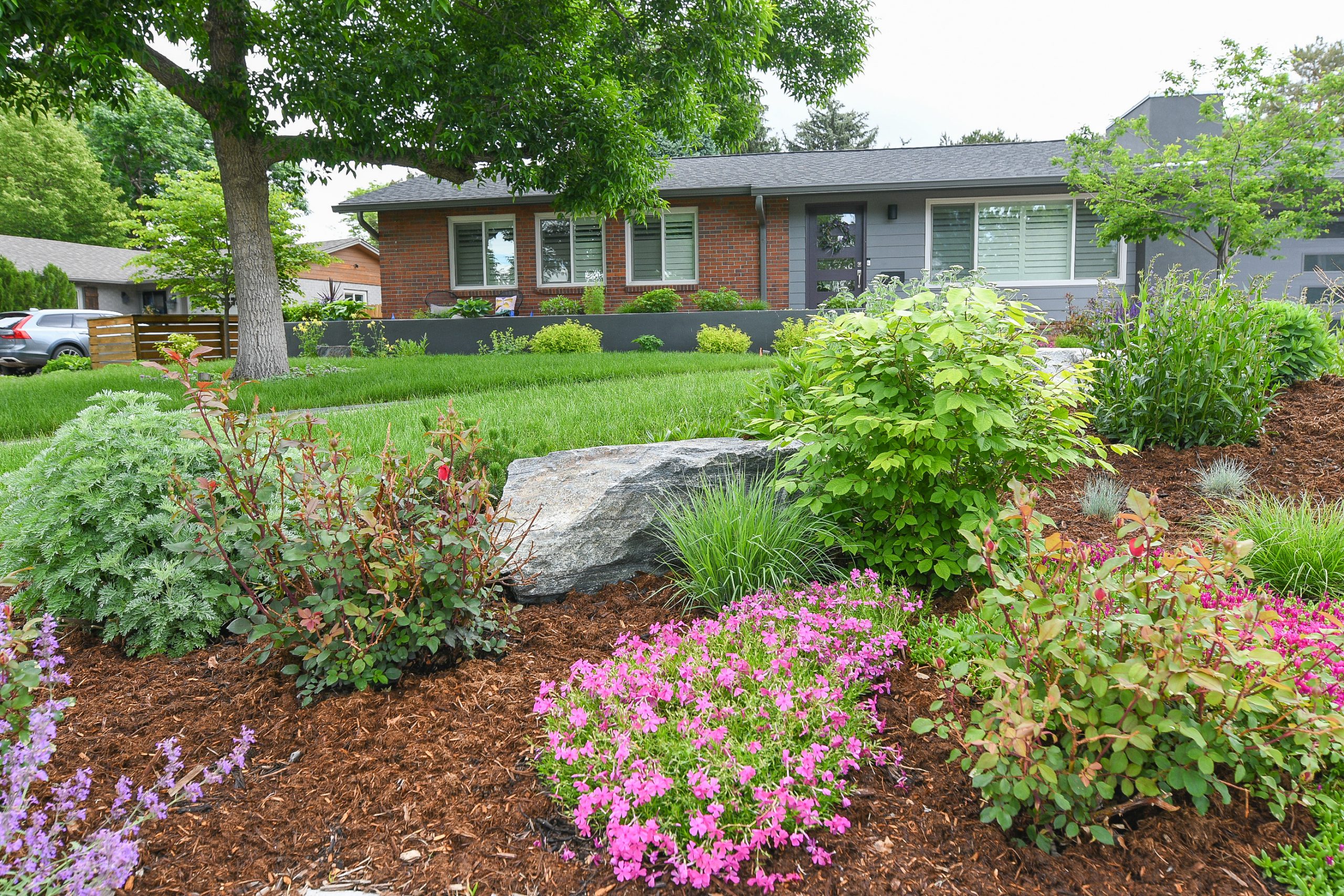Ready For The Next Phase?
Now that you’ve dreamed up and mapped out your perfect landscape, it’s time to select some favorites to install in your design. Here are some smart ways to choose plants, turf, grasses and other water-wise options that work for you.
You don’t have to sacrifice beauty to save water. There are plenty of gorgeous plant options that thrive in low-water conditions. Use these tips to select the perfect landscape-enhancing plants.
Choose plants that work for you. Look for low water grasses, trees, shrubs, plants and groundcovers that fit your environment. (Consider microclimate, location, sun exposure, desired maintenance, intended use and your budget.)
Mix it up. Select plants with varying colors, height and blooming seasons to create visual interest and pops of color throughout the year.
Give room for growth. Before you plant, find out how tall and wide each plant will grow to provide the space they need as they mature.
Create a color scheme. Select plants with complementary colors and use both warm and cool colors to create depth. Repeat the scheme throughout your landscape for a balanced color flow.
Visit PlantSelect.org, a local resource for plant selections, landscaping designs and helpful information. Here are some ways to explore:
| Discover the best plants for your landscape and download Free Waterwise Landscape Designs on the Plant Select website. | |
| Find local retailers and garden centers near you on Plant Select’s Member Garden center page. Call ahead to ask if they have the plants you want. |
You don’t have to sacrifice beauty to save water. There are plenty of gorgeous plant options that thrive in low-water conditions. Use these tips to select the perfect landscape-enhancing plants.
Stick with Perennials
Low-water perennials are a cost-effective choice; adding beauty to your yard year after year. Once established, all they need is natural precipitation with a little supplemental water during hot and dry parts of the season.
Investing In Expensive Trees & Shrubs?
Before taking the plunge:
-
- Set yourself up for success with high-quality soil. Learn more about Soil Preparation & Planting on our H2Overhaul page.
-
- Plant in areas with suitable amounts of heat and limited wind exposure.
-
- Consider how big each tree or shrub will grow to be (tall and wide), allowing ample room for them to mature.
Hydrozone for Maximum Savings
Group plants together according to how much water and sun exposure they need. This saves water and helps plants flourish.
Put high-water plants in easily accessible areas or in low-lying drainage areas, near downspouts or in the shade of other plants to utilize runoff and natural shade.
In areas that are harder to reach or aren’t easily accessible, plant low-water plants that require less frequent watering.
Get A Water-Wise Garden In A Box
Resource Central offers professionally designed gardens with a curated selection of beautiful perennial Xeric (low-water) plants to replace turf, reduce watering and generally promote conservation practices for landscapes. Order yours at the Resource Central website.
A few tips from our experts for your water-wise garden:
Fill your garden with color and texture with a design that features shrubs and easy-care perennials that look gorgeous year-round. Add an array of flowers that bloom from spring to fall to add variety and balance to your landscape.
Add fragrant flowers and foliage to attract bees and other pollinators. More pollinators in your garden will help your plants flourish and grow year after year.
Get creative with your design. A versatile plant selection can be used as a perimeter planting (planted down the sides of a yard) or widened for use in a broader bed by placing the largest plants in the center and mirroring the design on the other side.
**Find more **sample designs on the Plant Select website.

It takes a lot of water (and work) to keep a lawn lush and green. Plot your practical turf plan for a smarter, low-maintenance yard.
Design your landscape and determine your best turf options based sun exposure, irrigation, intended use, soil or water challenges, maintenance and your budget.
Explore this site to find a variety of low-water turf options, ground covers and hardscapes that can enhance your space.
Low traffic, hard to maintain areas: Groundcovers, drought-resistant flower gardens, ornamental shrubs and shade trees are perfect for areas that have been a real pain in the grass (near foundations, along medians or on steep slopes).
High traffic areas: Low-water turf is ideal for areas designed to accommodate children’s play, sports activities, entertaining and pets.
| Grass Type | Tall Fescue | Buffalograss | Kentucky Bluegrass | Dog Tuff Grass |
|---|---|---|---|---|
| Color | Light to dark green | Light green to blue green | Light to dark green | Bright green color |
| Length of Green Season | Long: March – December | Short: May – September | Long: March – December | Medium: early June – October |
| Mowing Requirement | More frequent/ grows fast | Infrequent/none | Less frequent | Does not require mowing |
| Fertilizer Requirement | Lower | Very low | Higher | Very low |
| Iron Chlorosis | Infrequent | Infrequent | More frequent | Infrequent to none |
| Disease Problems | Infrequent | Almost none | Can be disease prone | Infrequent |
| Insect Problems | Almost none | Almost none | Occasional/more common | Almost none |
| Traffic Tolerance | Excellent | Fair | Good | Excellent |
| Traffic Recuperation | Poor to fair | Poor to fair | Good to excellent | Good to excellent |
| Heat/Cold Tolerance | Excellent | Excellent | Excellent | Excellent |
| Shade Tolerance | Good to excellent | Poor to fair | Fair | Poor |
| Irrigation | 20-22” annually. | 8-15” annually. | 15-26” annually. Proper management can reduce water consumption. | Once established, water every 10-14 days. Apply ½-1” water. |
| Maintenance | Frequent spring mowing. Requires irrigation to survive – does not go dormant well. |
Infrequent mowing, irrigation and fertilization. | Amend soil to 6” before planting. Mow between 2-3”. Use mulching blade. Aerate once a year. Use organic fertilizer. |
Avoid using weed killers if possible. If you mow, start in early July. Mow every 5–7 days. Use organic fertilizer. |
In addition to low-water turf options, there are a variety of water-wise groundcovers and hardscapes can enhance your space.
Give Ground Covers A Go
Low-growing ground covers can be used as an alternative to turf in areas with low foot traffic. Usually chosen for texture, density and how well they spread and choke out weeds, ground covers enhance the soil by acting as a mulch.
During the first year, any new ground cover will require weeding and mulching, but once established, little care is needed.
Check out a diverse list of gorgeous ground cover options on the Plant Select website.
Say Yes To No-Water Hardscapes
Great for high-trac areas, hardscapes are the nonliving elements within a landscape. Hardscapes include patios, decks, fences, boulders, pathways and lighting. They save a lot of water, have multi-uses and look fantastic.
Expert Tip
Consider adding pervious pathways and surfaces to your space, which let water absorb into the ground.
Visit the Thornton Water YouTube for planting and alt turf inspiration.
To request a printable PDF version of the information on this page, please email water@ThorntonWater.com.
Plant Select Search: right plant right place
Plant Select’s list of water-wise plants
Plant Select Nurseries
Plant Select Dog Tuff Grass
CSU Perennial Gardening
CSU Extension Xeriscaping: Groundcover Plants (includes shade loving groundcover plants)
CSU Extension: Rock Garden Plants
CSU Extension’s list of trees for Colorado’s front range
Selecting the right grass for Rocky Mountain Yards
Download City of Thornton Plant List
Denver Botanic Garden Gardening Resources
Denver Botanic Garden Gardening Resources
Front Range Tree Recommendation List

